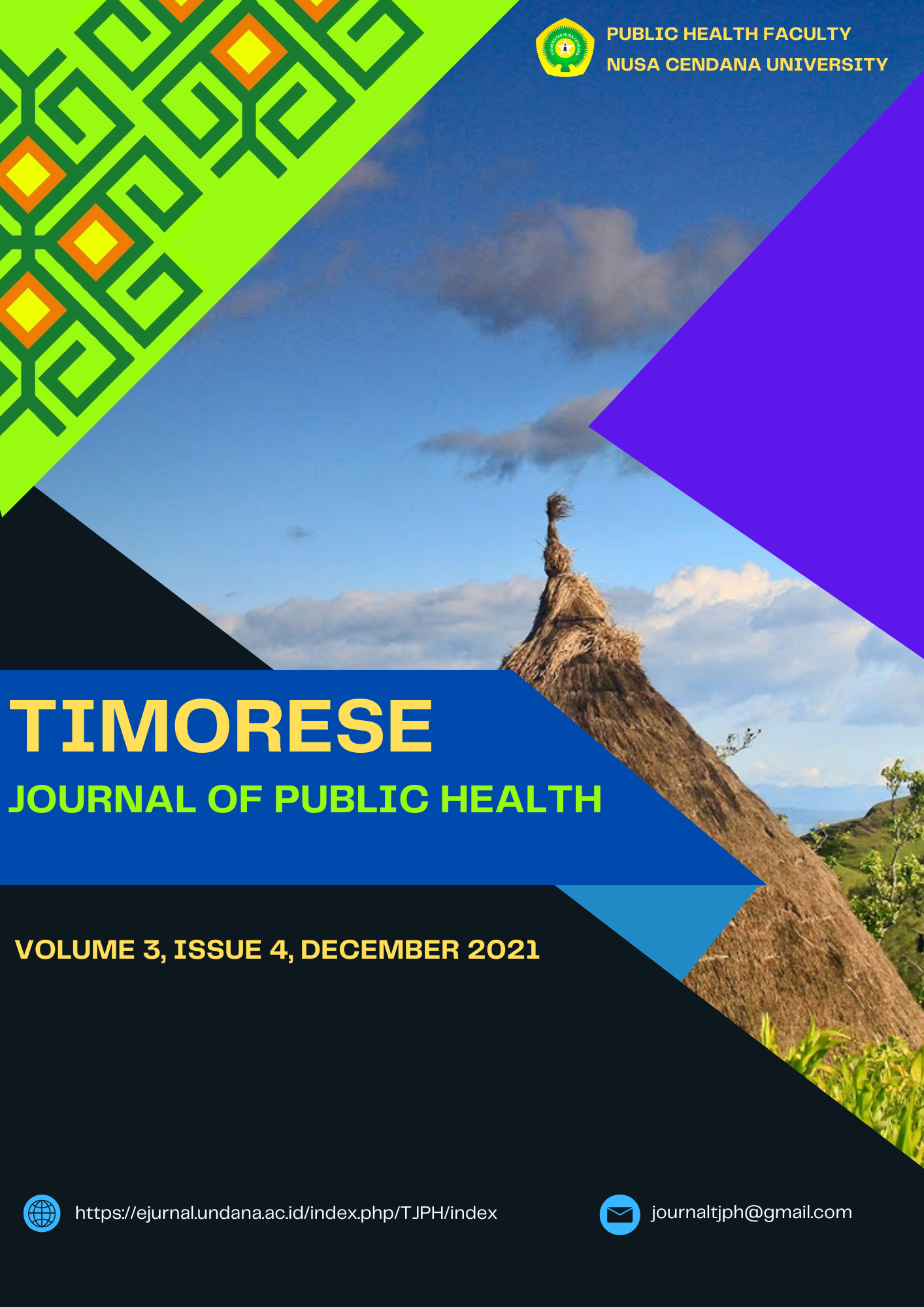Description of Sanitation in Traditional Markets in Atambua City
Main Article Content
Abstract
The market is one of the public places that need attention to environmental sanitation. This is because traditional markets in Indonesia are synonymous with dirty, smelly, muddy, stuffy places and become breeding grounds for disease-transmitting animals such as cockroaches, mice, flies and mosquitoes which can eventually transmit disease. The sanitation conditions of Pasar Baru and Pasar Lolowa generally have a dirty market environment, poor waste management system, smelly toilets and no hand washing facilities. This study aims to determine the description of market sanitation in traditional markets in Atambua City, Belu Regency. This type of research is quantitative with a descriptive design and a survey method approach. This research started in October-November 2021. The population in this study were all traditional markets located in Atambua, Belu Regency, while the samples of this study were Atambua Baru Market and Lolowa Market. Data were collected by means of observation and interviews with percentage analysis. The results showed that 40% of Atambua's New Market and 24% of Lolowa's Market were in a poor category according to the healthy market assessment form according to the Ministry of Health of the Republic of Indonesia in 2008. Healthy Market Sanitation for the New Market and Lolowa Market was categorized as lacking or not meeting the assessment requirements. Therefore, it is recommended to all parties, especially market managers to improve and improve market sanitation by providing trash bins, hand washing facilities, clean water facilities, closing the sewerage with lattices and dividing the existing toilets separately between men and women
Downloads
Article Details
References
2. Suparlan. Pengantar Higiene Sanitasi Tempat Umum Pariwisata & Bisnis untuk Masyarakat. 3rd ed. Surabaya: Merdeka Print; 2012. 262 p.
3. Dinas Kesehatan Kota Kupang. Profil Kesehatan Kota Kupang. 2019. 335–58 p. Available from: https://www.bps.go.id/linkTableDinamis/view/id/960.
4. Bahri S. Faktor-Faktor yang Mempengaruhi Sanitasi Pasar Bina di Gampong Ujong Kalak Kecamatan Johan Pahlawan Kabupaten Aceh Barat [Internet]. Teuku Umar University; 2014. Available from: http://repository.utu.ac.id
5. Syifa JNA, Rusman E. Status Kesehatan Pasar Ditinjau dari Aspek Lokasi dan Bangunan di Pasar Ciputat dan Pasar Modern BSD Kota Tangerang Selatan. J Kesehat [Internet]. 2018;ix, No. 1:1–6. Available from: http://journal.stikeshb.ac.id
6. Kemenkes RI. Peraturan Menteri Kesehatan Republik Indonesia Nomor 17 Tahun 2020 tentang Pasar Sehat [Internet]. 2020. 1–73 p. Available from: http://kesling.kesmas.kemkes.go.id
7. Prahastiwi LPE. Gambaran Umum Kondisi Sanitasi Pasar Desa Adat Kedonganan Kecamatan Kuta Kabupaten Badung Tahun 2019. Health Polytechnic Denpasar Ministry of Health; 2019.
8. Kemenkes RI. Keputusan Menteri Kesehatan Republik Indonesia Nomor 519/Menkes/SK/VI/2008 Tentang Pedoman Penyelenggaraan Pasar Sehat [Internet]. 2008. 40 p. Available from: https://www.academia.edu/10261502/KEPUTUSAN_MENTERI_KESEHATAN_REPUBLIK_INDONESIA_NOMOR_519_MENKES_SK_VI_2008_TENTANG_PEDOMAN_PENYELENGGARAAN_PASAR_SEHAT_MENTERI_KESEHATAN_REPUBLIK_INDONESIA
9. Putri NMCR. Gambaran Umum Kondisi Sanitasi Pasar di Pasar Umum Kusamba, Desa Kusamba, Kecamatan Dawan, Kabupaten Klungkung [Internet]. [Denpasar]: Health Polytechnic Denpasar Ministry of Health; 2018. Available from: http://repository.poltekkes-denpasar.ac.id/314/
10. Nucahya K, Moelyningrum A, Ningrum PT. Identifikasi Sanitasi Pasar di Kabupaten Jember (Studi di Pasar Tanjung Jember). J Kesehat [Internet]. 2014;2(2):285–92. Available from: https://jurnal.unej.ac.id/index.php/JPK/article/view/1787/1466
11. Yunanda F, Selviana, Prada TD. Gambaran Kondisi Sanitasi Pasar Tradisional Di Kota PontianakTahun 2015 (Studi Kasus Pasar Flamboyan Dan Pasar Mawar). J Kesehat. 2015;(1–12).
12. Amalia I. Hubungan antara Pendidikan, Pendapatan dan PerilakuHidup Bersih dan Sehat (PHBS) pada Pedagang HidangIstimewa Kampung (HIK) di Pasar Kliwon danJebres Kota Surakarta [Internet]. Public health. Muhammadiyah Surakarta University; 2009. Available from: http://eprints.ums.ac.id
13. Nabila SL, Mandagi AM. Gambaran Sanitasi Pasar Desa Impress Pujasera Di BanyuwangiTahun 2018. J Kesehat Masy [Internet]. 2018;12:1–16. Available from: http://jurnal.fkm.untad.ac.id/index.php/preventif
14. Ginting DSB. Tinjauan Sanitasi Pasar Kota KabanjaheKabupaten Karo Tahun 2017. Health Polytechnic, Ministry of Health, Medan; 2017.
15. Djamil S. Deskripsi Kondisi Sarana Dan Prasarana Sanitasi PasarShopping Centre di Kelurahan Kayubulan KecamatanLimboto Kabupaten Gorontalo Tahun 2012. J Kesehat. 2012;1–20.
16. Kemenkes RI. Profil Kesehatan 2007 [Internet]. 2007. 1–327 p. Available from: https://pusatim.kemkes.go.id

